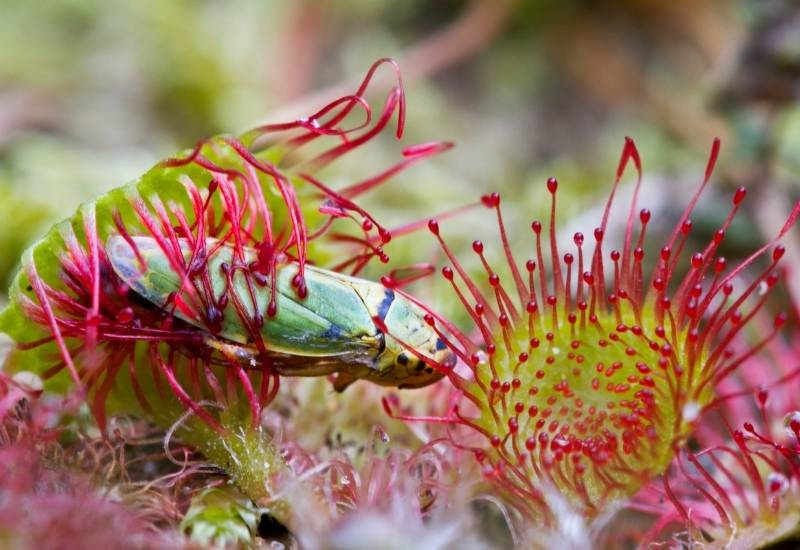
Venus flytrap, sundews, pitcher plants… All these are weird and exotic looking plants are several different types of carnivorous plants that eat insects – and sometimes even small mammals!
Insectivorous plants, commonly called carnivorous are a real quirk of Nature. Thus having one on your bookshelf will give you beauty, originality fun and… it will also eat those annoying insects too! But how can you grow them?
Carnivorous plants are adapted to living in places where the soil is poor in nitrogen, and this is why they eat bugs to absorb it. They most typically from exotic places like Southeast Asia and South America, but some come also from temperate regions. Growing them, though, is not the same as other plants.
If you are wondering what plants are related to the Venus fly trap, you will need a visual description (with a picture) of some wired looking flesh eating plants, as you will need to match plants with similar needs.
So, just read on and find wide range of insect eating plants you can choose from, and some along clear guidelines so you don’t end up “killing your living insect trap!”
But before you go and pick your favorite, read the guidelines on how to grow them successfully.
Getting to Know Carnivorous Plants
As we said, carnivorous plants don’t grow in your average forest or meadow. They are special plants. In fact, they don’t eat insects (and mice etc. in some cases) because they are gluttonous… No…
They do it because they grow where the soil is poor of nitrogen and phosphorus. This often means bogs, marshes, moors and similar types of environments. Some also grow in limestone rocky soils.
But because of their special feeding habits, they have developed amazing shapes. Some have tentacles; some have pitchers; others have long “teeth” and close when an insect walks on them… For a botanist, they are puzzling wonders… For gardeners (professional and amateurs alike) they are a unique opportunity to have “something different” in his or her collection.
And by the way… yes, carnivorous plants do have roots.
How To Grow and Care For Carnivorous Plants
I bet you have guessed already that because they are “strange”, you cannot expect to grow them like any other plant… And you are right! Many people end up killing their bug eating plant because they make even simple mistakes…
But they are not difficult to fare for. Once you know the basics, they are comparatively low maintenance. And here are our best tips for growing carnivorous plants.
You see? They are small changes you need to make, but if you get acidity, type of medium or watering wrong, you end up risking your plant’s life…
And now you know how to grow them, you only need to choose the one that’s best for you, and maybe learn a more about it. So… here we go!
13 Types Of Carnivorous Plants That Eat Bugs
There are more than 750 species of carnivorous plants currently recognized, and Venus fly trap is the most popular carnivorous plant with ability to catch and digest insects and other small animals.
So, what are some plants like Venus fly trap? here are 13 common and unusual carnivorous plant varieties that eat everything from bugs to small mammals:
1. Venus flytrap
2. Albany pitcher plant
3. Butterwort
4. Tropical liana
5. Waterwheel plant
6. Brocchinia
7. Sundews
8. Corkscrew plant
9. Cobra lily
10. Trumpet pitcher plant
11. Fly bush
12. Bladderworts
13. Pitcher plant
1. Venus Flytrap (Dionaea muscipula)
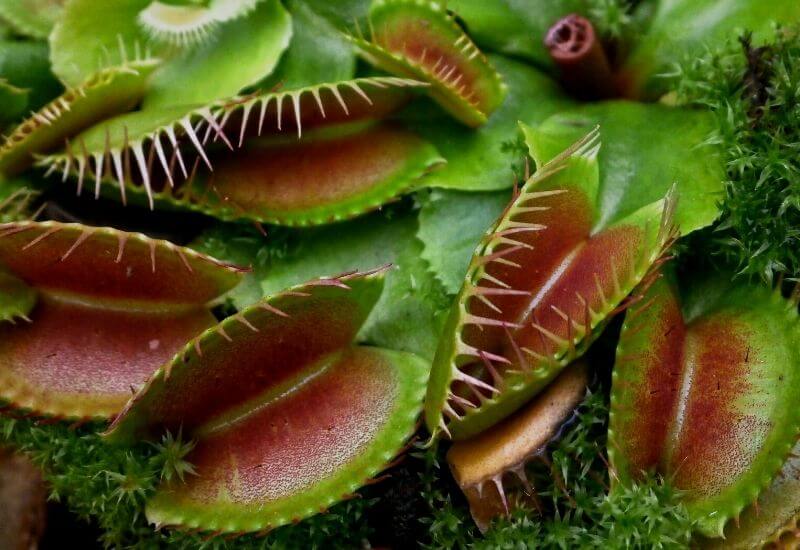
Let’s start with the most iconic and most popular carnivorous plant: Venus flytrap. This is actually a small menacing beauty… It only grows to 6 inches wide (15 cm) and the traps that you often see in closeups are only 1.5 inches long (3.7 cm)…
Still with those strange bright red pads that look a bit like the palate of a mouth, long spikes that look like the teeth of some deep water predator fish or horror film creature… This bug eater is an astonishing presence in terrariums and pots.
And there is more… It moves! Few plants actually move, and Venus flytrap is arguably the most famous of them all…
When a fly or other insect walks onto the traps, this little plant original of subtropical wetlands on the East Coast of the USA spots the new guest and… It closes the two pads of the trap, making any attempt to escape impossible.
In this, it is a playful plant, if macabre maybe. Children love it and adults too cannot resist the strange spectacle every time it catches a prey.
2. Albany Pitcher Plant (Cephalotus follicularis)
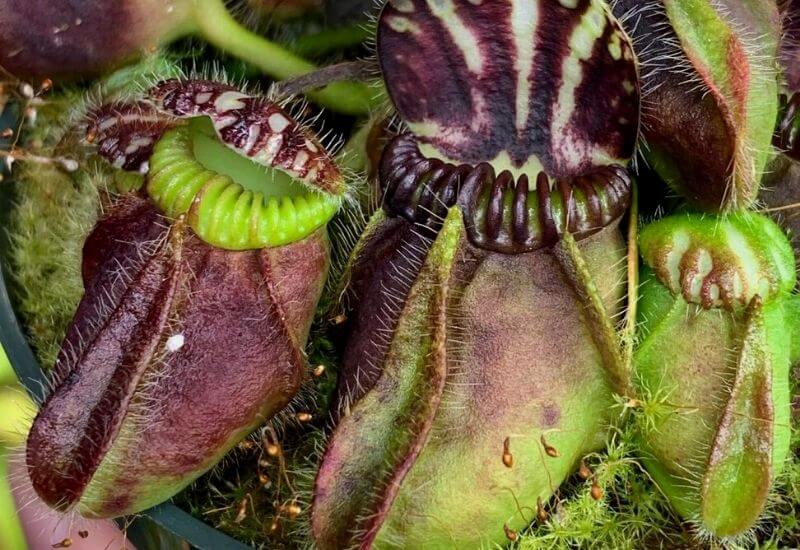
Another odd looking bug eating plant is Albany pitcher plant, a.k.a. moccasin plant. This strange wonder from Southeast Australia specializes in crawling insects, like ants, earwigs, centipedes etc.
So, it grows plump pitchers very close to the ground. But it also makes them very “climbing friendly”… It has large ribs on the sides with lots of thin “hairs”, which creepy crawlies use as step ladders…
But they don’t know where they are going… At the top of their climb there’s a peristome (like a lip, a rim, a rounded edge) with tiny ribs on it.
And these form “short paths” to the top… Where, unfortunately for the little insect, the peristome becomes slippery and there’s a large pitcher shaped hole waiting for it.
Once it falls in, it ends up in a liquid rich in enzymes and the plant eats it alive…
This plant has beautiful colors, light green, copper and purple, with a very waxy texture. But there is more… The lid on top of the pitcher has large ribs (that can be green, copper or purple) and in between “windows”… These are translucent parts of the plant.
Why? This is to let light into the pitcher, because apart from eating bugs, it also photosynthesizes!
This is a beautiful plant with lots of sculptural value and striking colors, and the pitchers can be 8 inches tall (20 cm) and about 4 inches wide (10 cm). They will put on a great show in a spot in full sight, like your work desk, a mantlepiece, a coffee table..
3. Butterwort (Pingiucula spp.)
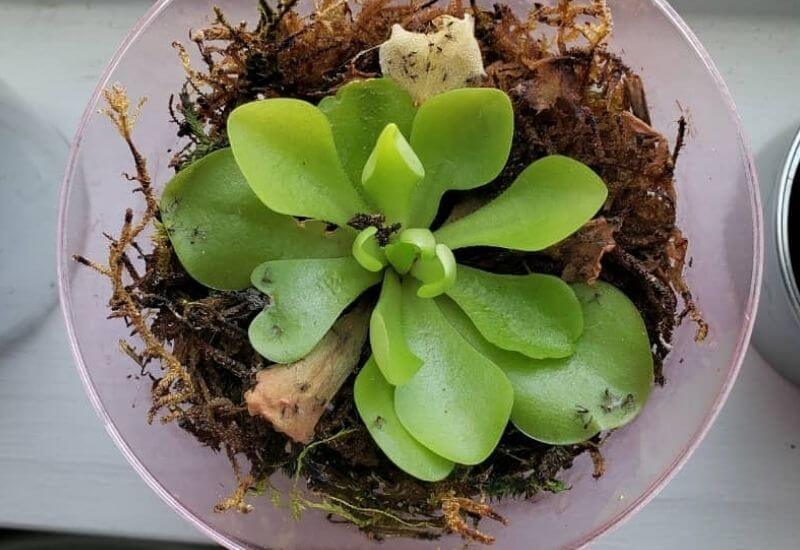
Did we say that some insect eating plants come from temperate regions too? Here is one, butterwort, which hails from Europe, North America and North Asia. Looking at it at first you may confuse it for an Alpine flower. Because it does have beautiful magenta to blue pansy like flowers…
But then you look at the leaves and you notice that something is strange… They are sticky, like covered with a layer if shiny and sticky hairs. And there are insects and little corpses stuck to the large and fleshy leaves…
This is how it catches them. It basically glues little creatures to its leaves and then sucks all the nutrients it needs from them.
This is a very good plant for a beautiful terrarium. Maybe it’s not as playful as a Venus flytrap or as sculptural as a moccasin plant, but in the right environment it does look great. With some shiny glass, lush, green and even exotic companions, this plant can look a bit like a strange “alien” or underwater plant.
The size depends on the species. The leaves can be as small as less than an inch (2 cm) or as big as a whole foot in length (30 cm).
4. Tropical Liana (Triphyophyllum peltatum)

A very rare carnivorous plant, Tryphiophyllum peltatum is the only species in its genus. It comes from the tropical Western Africa (Liberia, Sierra Leone and Ivory Coast). It does not look like most other insect eating plants as well…
It has two types of leaves, green and glossy and in a way it may look like a palm or a decorative fern…
One set of leaves is lanceolate, and these leave insects alone… But then it grows another set. And these are long and slender – quite attractive and shiny to be honest. But this set has glands on it that capture the little visitors…
While it would be a wonderful carnivorous plant to grow, there are two problems… It has stems that can reach 165 feet long (50 meters)! So, you need a park more than a garden to grow it.
Second, so far it is grown in some botanical gardens. Only three to be exact: Abdijan, Bonn and Würzburg.
A fun fact… No one understood it was an insectivorous plant until 51 whole years after its discovery!
You are unlikely to grow it but in case, a few tips may come in handy, though we know little about caring for this plant.
5. Waterwheel Plant (Aldrovanda vesiculosa)
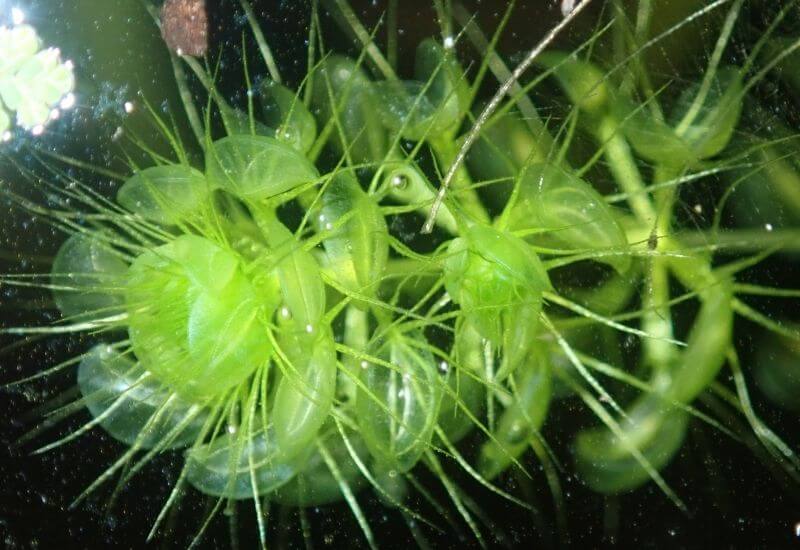
A less eye catching bug eating plant, waterwheel plant still has its appeal… in a way, the name is very apt, because it looks a bit like some of the water plants you have in aquariums. It has a long, ropy green stems with, at regular intervals, sketched flat leaves and green hairs coming off them. It may remind you of Equisetum, to give you an idea.
But unlike Equisetum, waterwheel plant uses those long and thin green “hairs” to capture little invertebrates that swim in the water.
Yes, because this insectivorous plant is different from all others… It has no roots and it lives in water.
It looks good in an aquarium or in a bowl of water, so, no need for watering nor soil. It is also a special plant because it is the last surviving species from its genus, and it is an endangered species, so, if you grow some, you will help its preservation as well.
6. Brocchinia (Brocchinia reducta)
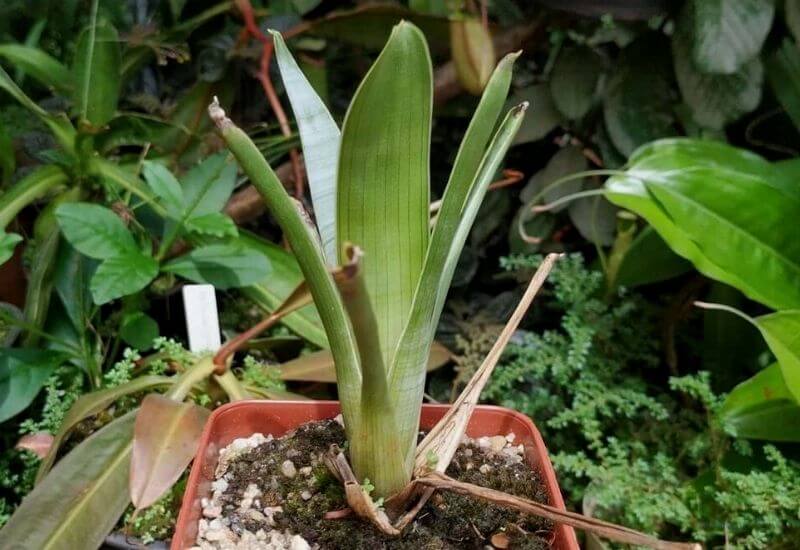
Another special carnivorous plant, Brocchinia is also a succulent and a bromeliad. It has the typical pineapple leaf shape, with a large, beautiful rosette of sleek looking and flesh leaves. These are of a green to silver green or bluish green.
They also have a light pattern of light stripes on them. These are first upright, then they open out, forming a rosette that can be between 3 and 12 inches tall and wide (7.5 to 30 cm).
The ideal houseplant then…
Also because it catches flies and mosquitoes…
But how does it do it? In the middle of the leaves, where we water similar bromeliads, this one has water too…
But it is very acidic (2.8 to 3.0) and filled with enzymes that digest the unlucky insects that slip into it.
Last but not least, this plant’s liquid also smells very nice and sweet. Just don’t fall for it as insects do. It’s a trap!
7. Sundews (Drosera spp.)
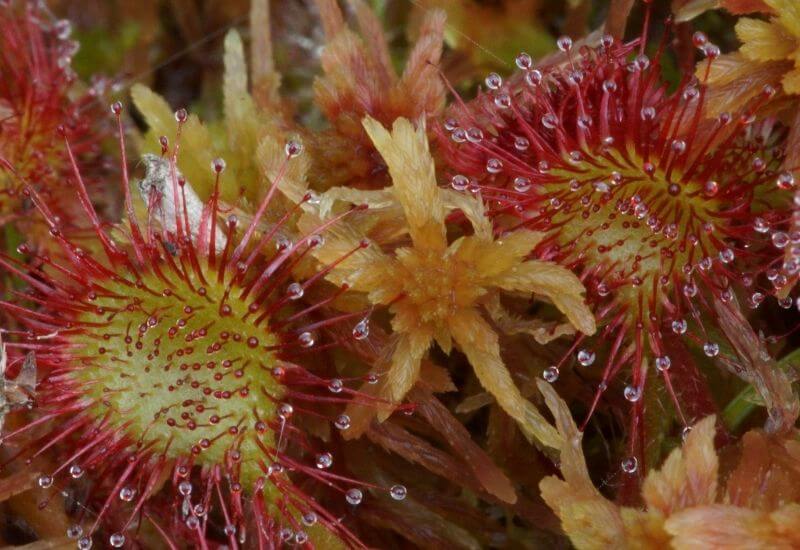
Sundews are one of the most known, common and iconic carnivorous plants in the world. Though it may suffer from being overshadowed by Venus flytrap, the 194 species in this genera are quite famous indeed.
You know what I am talking about? Sundews are those tiny, plants whose modified leaves are full of sticky hairs, that look like they have a drop of transparent glue at the tips… Those leaves that curl up when an gets stuck in them…
The plants have a strange growing habit… They tend to lie flat on the ground, a bit like treacherous carpets or door mats… So insects don’t even realize that they are walking into a trap!
They have flaming red in them, and also light green. The contrast is clearly an eye catching “neon sign” for little creatures… But in a terrarium or pot, these colors are very attractive.
Their size usually ranges between 7 and 10 inches in diameter (18 and 25 cm), so you can fit one on a shelf or in a corner of your desk…
8. Corkscrew Plant (Genlisea spp.)
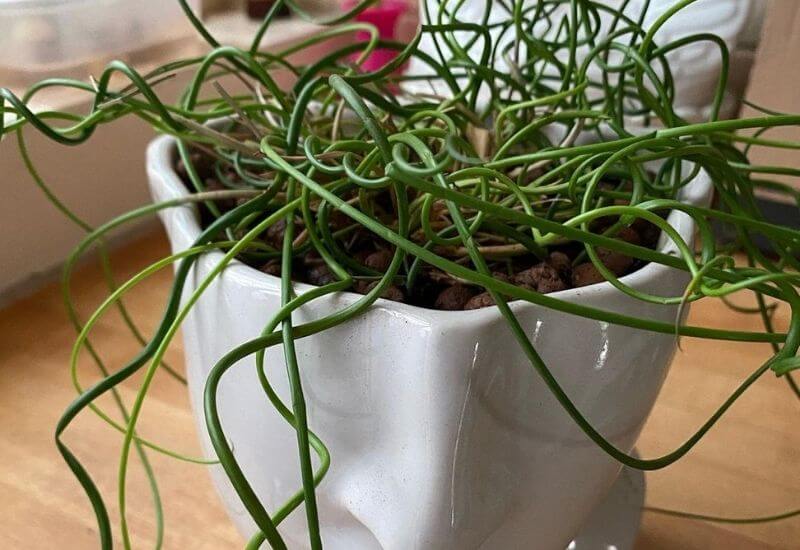
Corkscrew plant is a semi-aquatic insectivorous genus of plants comprising about 30 species.
While it may not be showy, it looks exotic and weird at close range, and it does add a lot of originality to compositions, especially in terrariums even when not in bloom…
Yes, because this is a blooming bug eater, and some species actually have very beautiful flowers, like Genlisea aurea (with a dark yellow, almost ochre flower) and Genlisea subglabra (lavender).
These are really odd shaped and exotic. They look a bit like dancing women with long skirts…
But the leaves are very pretty too. They end to be round, shiny and fleshy and shaped a bit like tea spoons.
They are small plants you can keep on your desk. The biggest is 4 to 5 inches across (10 to 12.5 cm).
9. Cobra Lily (Darlingtonia californica)
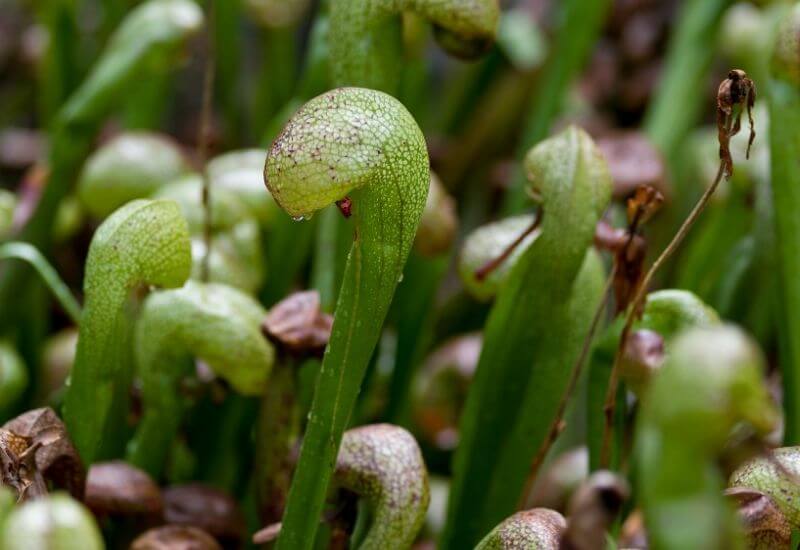
Talking of very unusual flesh eating plants… Meet cobra lily, also known as California pitcher plant… It does in fact have a pitcher, like the famous Nepenthes, but…
The overall shape of the plant is that of a cobra standing up and ready to bite… That alone makes it impressive, but that’s not all…
The pitchers are actually translucent! You can see the light getting through them! That makes them look like strange glass statues… It does have a reason… They do this to confuse insects. and there is more…
They colors are stunning! The are a few flaming red veins running along the pitchers, and usually concentrating “under the neck” of the snake, a bit like in robins. Then, there are light green veins all over… and in between them, translucent spots that are almost colorless!
They are also quite big, about 3 feet tall (90 cm), so no one coming to your home or garden will ever miss them!
10. Trumpet Pitcher Plant (Sarracenia spp.)
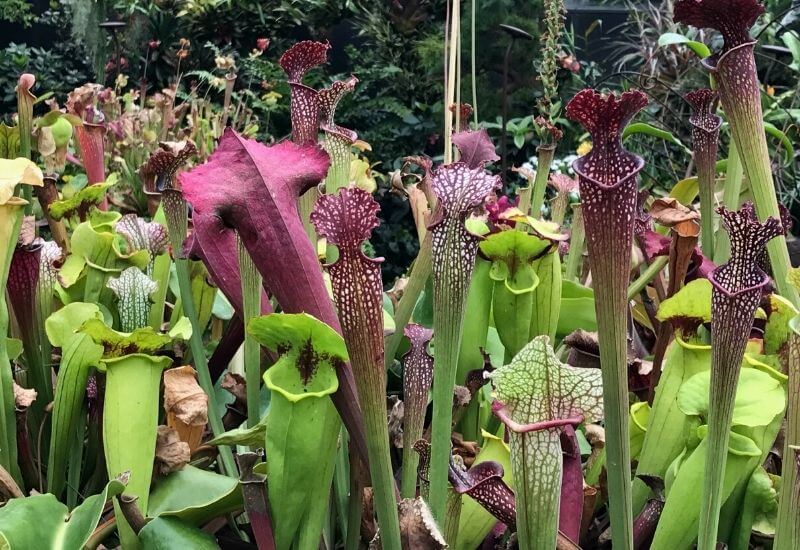
This type of carnivorous plant has pitchers too, but unlike Nepenthes, they don’t grow on branches but straight from the ground. And they are very long (20” to 3 feet tall, or 50 to 90 cm) and thin, with no ribs or “wings on them”.
Grown in clumps the display is stunning, very architectural and – colorful!
Yes, because the species (8 to 11, scientists have not agreed yet) of this genus start bright green at the bottom of the pitcher and then they turn colorful where the trap mouth is placed…
A clever way to attract curious insects where they want them….
And what colors! Flaming red, purple, bright yellow! These often have patterns formed by veins, and a clump of trumpet pitcher plants is a real spectacle.
And once a year, a long stem will rise from them and bear a wonderfully tropical flower too!
11. Fly Bush (Roridula spp.)
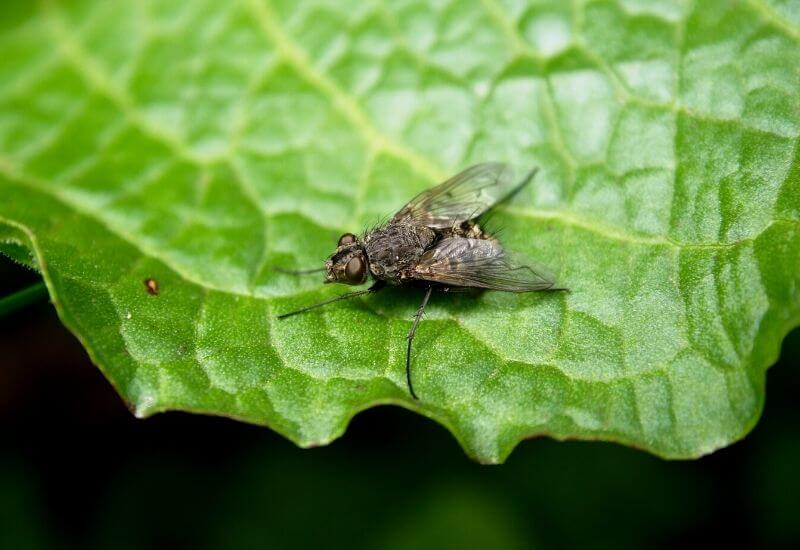
As insect eating groups of plants go, this is tiny indeed. It is a family (Roridulaceae) with only one genus, and a genus with only one species.
So, they are two plants in the end… one bigger (6 feet and 7 inches, or 2 meters tall) and the other smaller (4 feet or 1.2 meters tall). They are very odd and original too… Just bear with me.
Like many strange plants, they come from South Africa, where they grow at high altitudes on mountains.
They look a bit like spiky shrubs, which will add a great architectural value to patios and gardens, though you need to grow them in containers.
The long traps that are its leaves start from the base and form large rosettes. The leaves have sticky tentacles which capture insects.
But they are less sticky than Drosera, so, crawling guests start by getting a little foot stuck and, as they struggle to get free, they end up becoming immobilized.
But there’s more. From September to December, this plant is in bloom with beautiful flowers with five white and red and green sepals.
12. Bladderworts (Utricularia spp.)
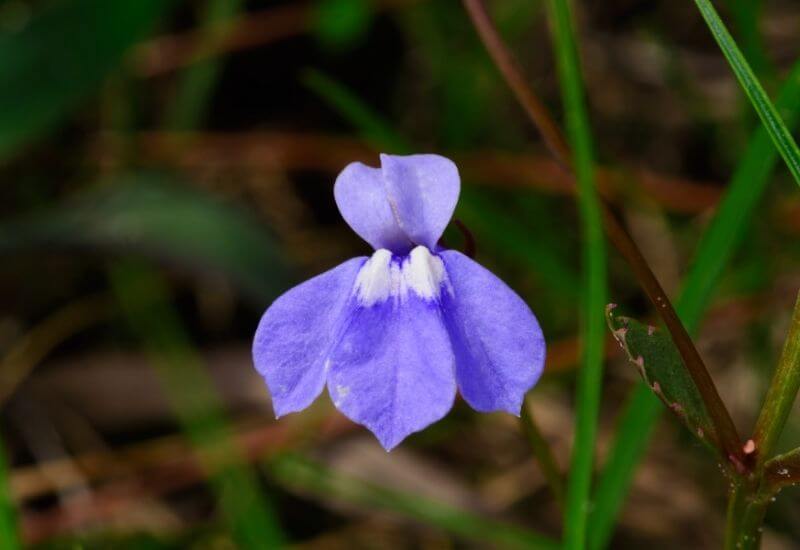
These are very strange carnivorous plants indeed… The 215 species of this genus in fact use “bladders” that can be between 0.2 mm (microscopic) and ½ inch (1.2 cm) in size. But these are not above ground… No!
They are attached to the roots! Why? Because these plants eat very small creatures that live in the ground or in the water.
Correct, in the water… This is because some common species like Utricularia vulgaris are aquatic and they feed on fish fry, mosquito larvae, nematodes and water flees. They prefer seafood, basically…
The plants are unassuming, with a few tiny leaves at the base, but the flowers are quite exotic looking and beautiful.
They look like butterflies and they appear on long stems. They are usually white, violet, lavender or yellow.
If you need to keep the population of insect larvae of your pond at bay, you can do it with lovely flowers that pop out of the water as if out of nowhere.
13. Pitcher Plant (Nepenthes spp.)
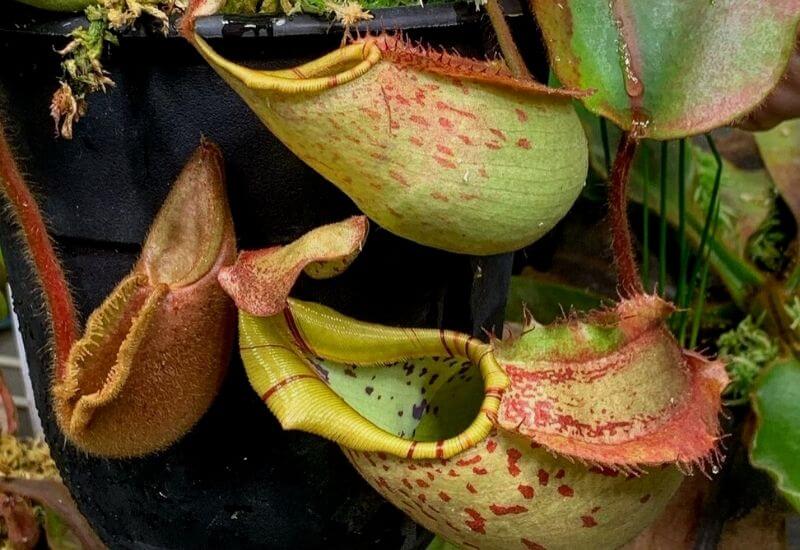
We finally come to the iconic pitcher plant! These wonderful and exotic bug eating plants come from all over the Indian Ocean basin, and there are about 170 species at the moment, but new ones are being discovered all the time.
They like to grow in very wet rainforests and at their margins, often at fairly high altitudes. This means that they are not easy to discover…
You know which plant I am talking about… Those exotic looking bug eating shrubs with waxy oval leaves and pitchers hanging underneath them…
They are just fantastic… They can turn any garden into a full blown exotic paradise with their presence.
And people are loving them more and more. In fact, they were once found only in botanic gardens (I still remember when I first saw one at Kew), but now you can buy them online and grow them yourselves.
The pitchers are usually in a combination of colors: light green, red, yellow, orange and purple.
Some species like Nepenthes vogeliihave spots (yellow on purple in this case). Others have beautiful stripes with striking color contrasts, like Nepenthes mollis.
The pitchers vary in size, reaching 1 foot in height (30 cm) and 4.5 inches in width (14 cm). The plants too go from short specimens that reach a foot (30 cm) to giants ten times taller (10 feet or 3 meters).
The Weird and Amazing World of Carnivorous Plants
You will admit that bug eating plants are just sensational! If you like the unusual, you will certainly fall in love with them…
And you can get the best of both worlds with them: a strikingly beautiful plant and fewer insects around, great isn’t it? For you, that is, not for the poor little insects…

Written By
Amber Noyes
Amber Noyes was born and raised in a suburban California town, San Mateo. She holds a master’s degree in horticulture from the University of California as well as a BS in Biology from the University of San Francisco. With experience working on an organic farm, water conservation research, farmers’ markets, and plant nursery, she understands what makes plants thrive and how we can better understand the connection between microclimate and plant health. When she’s not on the land, Amber loves informing people of new ideas/things related to gardening, especially organic gardening, houseplants, and growing plants in a small space.

Love all plants. Just trying to raise these.